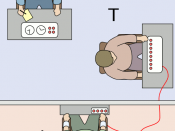Lauren Summers
The Social Approach exam questions
17 (a) one assumption of the social approach is that the people we're around and the situation we're in is a major influence on our behaviour.
(b) The social approach can explain helping behaviour because if a person is in a situation where they are surrounded by lots of people and sees an old lady fall over they may not volunteer to help because they assume one of the other people around them will help the woman which is known as diffusion of responsibility. Whereas if a person saw an old lady fall over and there was nobody else around them to they would be more likely to help the woman and see if she was okay.
(c) One similarity between Milgram & Piliavin's studies is that they both had the same issues with ethics. In Milgram, may Ps showed signs of extreme stress such as sweating, trembling and fidgeting.
Some even left the study feeling guilty about the fact they had it within themselves to kill a person. This is proof Milgram's Ps weren't protected. In Piliavin's experiment the Ps weren't aware they were taking part in a social experiment so might have started to stress when seeing a stranger suddenly collapse or if they didn't help they might've later started to feel guilty and bad about themselves because they could've stepped in but didn't.
One difference is that Milgram debriefed his Ps about what his experiment was about and what was going to happen with the teacher & learner set up, word pairs and the shocks. Milgram debriefed his Ps because they had volunteered themselves to be a part of the study and it would be unethical not too. Whereas Piliavin was unable to debrief his Ps partly because there were...


